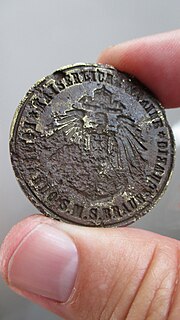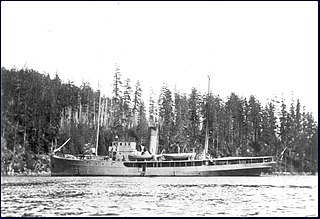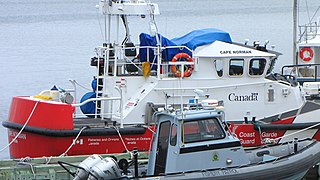
A ship prefix is a combination of letters, usually abbreviations, used in front of the name of a civilian or naval ship that has historically served numerous purposes, such as identifying the vessel's mode of propulsion, purpose, or ownership/nationality. In the modern environment, prefixes are cited inconsistently in civilian service, whereas in government service a vessel's prefix is seldom omitted due to government regulations dictating that a certain prefix be used. Today the common practice is to use a single prefix for all warships of a nation's navy, and other prefixes for auxiliaries and ships of allied services, such as coast guards. For example, the modern navy of Japan adopts the prefix "JS" – Japanese Ship. However, not all navies use prefixes. Among the blue-water navies, those of France, Brazil, China, Russia, Germany, and Spain do not use ship prefixes. NATO designations such as FS, FGS, and SPS can be used if needed.

His or Her Majesty's Ship, abbreviated HMS and H.M.S., is the ship prefix used for ships of the navy in some monarchies. Derived terms such as HMAS and equivalents in other languages such as SMS are used.
The designation His Majesty's Canadian Ship, is applied as a prefix to surface ships in the Royal Canadian Navy and Canadian Joint Operations Command. The similar designation of His Majesty's Canadian Submarine is applied to submarine vessels.
United States Ship is a ship prefix used to identify a commissioned ship of the United States Navy and applies to a ship only while it is in commission. Before commissioning, the vessel may be referred to as a "pre-commissioning unit" (PCU), but is officially referred to by name with no prefix. After decommissioning, it is referred to by name with no prefix, though people commonly refer to those ships with the prefix "ex-", as in ex-ship name. In-service but non-commissioned Navy ships go by the prefix USNS, which stands for United States Naval Ship.
A cargo ship or freighter is a merchant ship that carries cargo, goods, and materials from one port to another. Thousands of cargo carriers ply the world's seas and oceans each year, handling the bulk of international trade. Cargo ships are usually specially designed for the task, often being equipped with cranes and other mechanisms to load and unload, and come in all sizes. Today, they are almost always built of welded steel, and with some exceptions generally have a life expectancy of 25 to 30 years before being scrapped.

The Royal Indian Navy (RIN) was the naval force of British India and the Dominion of India. Along with the Presidency armies, later the Indian Army, and from 1932 the Royal Indian Air Force, it was one of the Armed Forces of British India.

Maritime powers in the Indian subcontinent have possessed navies for many centuries. Indian dynasties such as the Cholas used naval power to extend their influence overseas, particularly to Southeast Asia. The Marakkar Navy under Zamorins during 15th century and the Maratha Navy of the 17th and 18th centuries fought with rival Indian powers and European trading companies. The East India Company organised its own navy, which came to be as the Bombay Marine. With the establishment of the British Raj after the Indian Rebellion of 1857, the small navy was transformed into "His Majesty's Indian Navy", then "Her Majesty's Indian Marine", and finally the "Royal Indian Marine".

HMCS Galiano was a Canadian government fisheries patrol vessel pressed into service with the Royal Canadian Navy in 1917 during the First World War. Used for patrol and assessment duties on the West Coast of Canada, Galiano disappeared in a storm in October 1918, making her Canada's only warship lost during the First World War.

His Majesty's Naval Service is the United Kingdom's naval warfare and maritime service. It consists of the Royal Navy, Royal Marines, Royal Fleet Auxiliary, Royal Naval Reserve, Royal Marines Reserve and Naval Careers Service. The term Naval Service should be distinguished from the "UK Naval Services", which consist of the Naval Service and the Merchant Navy. The Naval Service as a whole falls under the command of the Navy Board, which is headed by the First Sea Lord. This position is currently held by Admiral Sir Ben Key. The Defence Council delegates administration of the Naval Service to the Admiralty Board, chaired by the Secretary of State for Defence.
A Royal Research Ship (RRS) is a merchant navy vessel of the United Kingdom that conducts scientific research for Her Majesty's Government. Organisations operating such ships include; the Natural Environment Research Council (NERC), the British Antarctic Survey (BAS) and the National Oceanography Centre (NOC). A warrant from the Queen is required before a ship can be designated as an RRS.
Her or His Majesty's Australian Ship (HMAS) is a ship prefix used for commissioned units of the Royal Australian Navy (RAN). This prefix is derived from HMS, the prefix used by the Royal Navy of the United Kingdom, and can be equally applied to warships and shore bases.
The Articles of War are a set of regulations drawn up to govern the conduct of a country's military and naval forces. The first known usage of the phrase is in Robert Monro's 1637 work His expedition with the worthy Scot's regiment called Mac-keyes regiment etc. and can be used to refer to military law in general. In Swedish, the equivalent term Krigsartiklar, is first mentioned in 1556. However, the term is usually used more specifically and with the modern spelling and capitalisation to refer to the British regulations drawn up in the wake of the Glorious Revolution and the United States regulations later based on them.

Public Armed Ship Muirchú was a ship in the service of Irish Free State's Coastal and Marine Service (CMS). She was the former Royal Navy ship HMY Helga and was involved in shelling Liberty Hall in Dublin from the River Liffey with her pair of 12-pounder naval guns during the Easter Rising of 1916.

The designation Canadian Coast Guard Ship is applied as a prefix to vessels in the Canadian Coast Guard.
A number of vessels of the British revenue services, at times known as the Inland Revenue, HM Customs and Excise, HM Revenue and Customs, and most recently UK Border Agency, have been named Vigilant:
Her or His Majesty's Armed Vessel (HMAV) was a ship prefix formerly used for certain Royal Navy ships.

Serco Marine Services is a Private Finance Initiative contract, with Serco Group, to deliver auxiliary services to Her Majesty's Naval Service.








